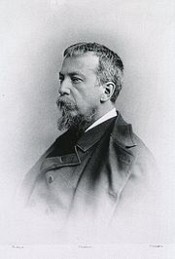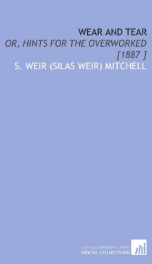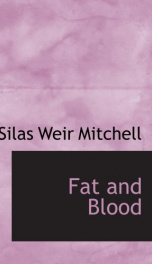Silas Weir Mitchell (February 15, 1829–January 4, 1914) was an American physician and writer. He was son of a physician, John Kearsley Mitchell (1798–1858), and was born in Philadelphia, Pennsylvania. He studied at the University of Pennsylvania in that city, and received the degree of M.D. at Jefferson Medical College in 1850. During the Civil War he had charge of nervous injuries and maladies at Turners Lane Hospital, Philadelphia, and at the close of the war became a specialist in neurology. In this field Weir Mitchell's name became prominently associated with his introduction of the rest cure, subsequently taken up by the medical world, for nervous diseases, particularly hysteria; the treatment consisting primarily in isolation, confinement to bed, dieting and massage. His medical texts include Injuries of Nerves and Their Consequences (1872) and Fat and Blood (1877). Mitchell's disease (erythromelalgia) is named after him. In 1863 he wrote a clever short story, combining physiological and psychological problems, entitled "The Case of George Dedlow", in the Atlantic Monthly. Thenceforward, Mitchell, as a writer, divided his attention between professional and literary pursuits. In the former field, he produced monographs on rattlesnake poison, on intellectual hygiene, on injuries to the nerves, on neurasthenia, on nervous diseases of women, on the effects of gunshot wounds upon the nervous system, and on the relations between nurse, physician, and patient; while in the latter, he wrote juvenile stories, several volumes of respectable verse, and prose fiction of varying merit, which, however, gave him a leading place among the American authors of the close of the 19th century. His historical novels, Hugh Wynne, Free Quaker (1897), The Adventures of François (1898) and The Red City (1909), take high rank in this branch of fiction. He was also Charlotte Perkins Gilman's doctor and his use of a rest cure on her provided the idea for "The Yellow Wallpaper", a short story in which the narrator is driven insane by her rest cure. He was a friend and patron of the artist Thomas Eakins. Following Eakins's 1886 firing from the Pennsylvania Academy of the Fine Arts, he may have suggested the artist's trip to the Badlands of North Dakota . The Philadelphia Chippendale chair seen in several Eakins paintings -- such as William Rush Carving his Allegorical Figure of Schuylkill River (1877) and the bas-relief Knitting (1883) -- was owned by Mitchell. The artist John Singer Sargent painted two portraits of Mitchell, one is in the collection of the College of Physicians of Philadelphia, the other, commisioned by the Mutual Assurance Company of Philadelphia in 1902, was recently sold (see External Links, below). In memory of his daughter Maria, Mitchell commissioned a monument from the sculptor Augustus Saint-Gaudens, The Angel of Purity (a white marble version of Amor Caritas), now in the Philadelphia Museum of Art.[1] Dr. Mitchell's eminence in science and letters was recognized by honorary degrees conferred upon him by several universities at home and abroad and by membership, honorary or active, in many American and foreign learned societies. In 1887 he was president of the Association of American Physicians and in 1908–09 president of the American Neurological Association. New International Encyclopedia This article incorporates text from the Encyclopædia Britannica, Eleventh Edition, a publication now in the public domain.











